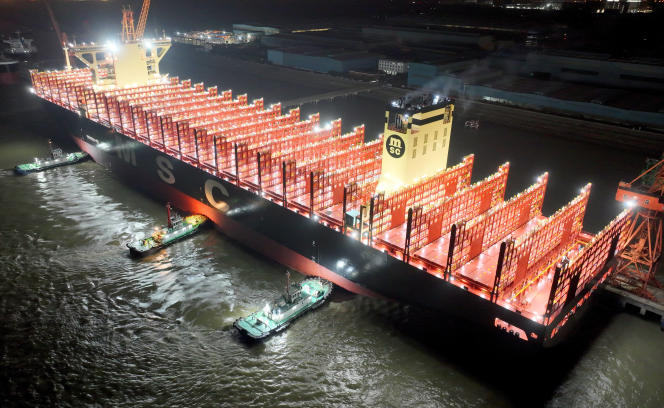The major traffic jams at the entrance to ports, the frantic search for containers and ships to transport them, the five to tenfold increase in freight rates, demanded by shipowners from their shipper clients… All these tensions observed between mid-2020 and mid-2022 seem like a distant memory. The price of shipping boxes has returned to normal and the bottlenecks have disappeared.
It is now the specter of overcapacity, an endemic problem in maritime transport shipping, which resurfaces. It is not as worrying as after the financial crisis of 2008, when demand from customers of the maritime giants collapsed, but it will continue to weigh on freight rates, and therefore the profits of the companies, until during 2024.
In 2021-2022, companies achieved unprecedented profits: more than 300 billion dollars (280 billion euros). They then ordered nearly 900 ships from Chinese and South Korean shipyards, often using liquefied natural gas (LNG), sometimes using methanol, such as the Taiwanese Evergreen, the Chinese Cosco or the Israeli Zim. And above all the Italian-Swiss MSC, which consolidated its first place in the world won at the start of 2022, with a capacity of 5.3 million twenty-foot equivalent containers (TEU), followed by the Danish Maersk (4.15 million). The Alphaliner firm estimates that at the rate of its investments, the French CMA CGM will become the second shipowner in 2026.
“A difficult time”
But these steel behemoths capable of transporting 18,000 to 24,000 TEUs take to the sea in bad weather, at a time when world trade is contracting. Containerized flows fell by 3.9% in 2022 (to 173.6 million TEU), explains Container Trades Statistics. The movement continues, and the ports are recording a clear drop in the handling of “boxes”. Maersk anticipates a 4% decline in overall demand for this mode of transport this year.
“There is a risk on the supply side” of boats in the next twelve to eighteen months, warned its boss, Vincent Clerc, in August, on Bloomberg TV. CMA CGM announced, shortly before, that “deliveries of new capacities should weigh on freight rates and particularly on the east-west axes”from Asia to Europe and the east coast of the United States, the main trade corridors with the transpacific. “Carriers face a difficult time in the contract market due to low demand and increased vessel capacity, leading to widespread rate reductions in the long term”, confirms the Norwegian firm Xeneta.
You have 61.98% of this article left to read. The rest is reserved for subscribers.
